ISSUE 11




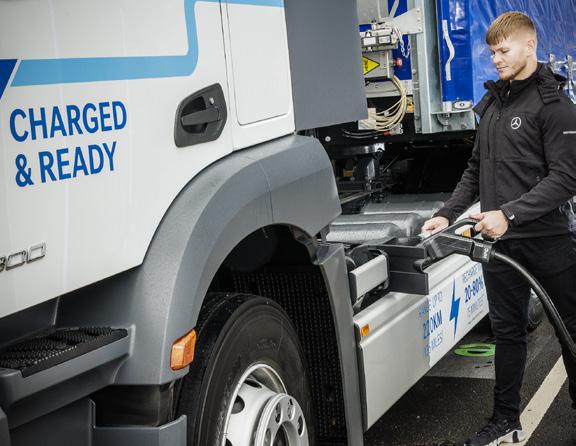





























The big news for this issue is that Destination Net Zero Magazine will be out promoting low and no carbon transport solutions in force in our own dedicated area at the 2024 Commercial Vehicle Show.
As our magazine’s own title makes plain, our attitude has always been that achieving net zero emissions from road transport is a process, and not something that can be established overnight in a single leap forward.
So the Destination Net Zero Area at the Commercial Vehicle Show will demonstrate the solutions that are available to operators now, and in the near future, as well as those that might still be a bit further down the road.
We will have input from manufacturers who market diesel trucks that can run on HVO without modification: and if this seems like small potatoes, remind yourself that making the switch from mineral diesel to HVO alone can yield a well-to-wheel reduction in CO2 in the order of 90 per cent without any further intervention. With own-account hauliers and the customers of third-party logistics
providers now focusing on Scope 1, 2 and 3 carbon emissions, the switch to HVO presents all transport concerns, large and small, with an opportunity to sell and profit from an environmental advantage without making huge investments in specialist equipment.
It’s not just road vehicles that emit CO2, of course. There’s also the vexed question of diesel emissions from the donkey engines that power most fridge bodies and trailers.
If you are looking for the latest carbonreduction solutions in the field of temperature control then you can see what’s on offer from Hulsteins, Schmitz Cargobull, and SDC Trailers.
On top of that there will be the latest low or zero-emissions truck technology from Isuzu Truck, Iveco, Mercedes-Benz and Renault, with other exciting exhibitors still to be confirmed.
The main body of the Show will also have a wide variety of electric light commercial vehicles and support systems from the likes of Ford, Harris Maxus, Addax, B-ON, Bradshaw, IA Electric Vehicles, Plug Me In, and more.
But before all that, there’s this issue of Destination Net Zero to read: we’ve got driving impressions of Mercedes electric trucks and vans, the launch of a new family of Volvo electric trucks, an important message about the environmental and financial benefits of using remoulded truck tyres, and the latest not just on the impact that government quotas will have on the new van market, but also how van salesmen can acknowledge and address some of the objections that van buyers, particularly those from SME businesses, may have to going electric.
There’s also interesting news on a massive investment from oil company bp into installing the UK’s most ambitious etruck charging station at England’s busiest truck stop.
As a magazine, we’ve never been shy about discussing the obstacles on the route to net zero, but it must be said that this magazine shows that for every potential problem, there’s a potential solution. Read on to find out more!
Matthew Eisenegger, Publisher
EDITORIAL
Publisher: Matthew Eisenegger
Managing Editor: Richard Simpson
Designer: Harold Francis Callahan
Editorial
Email:
Advertising
Email:
DESIGN
Art
Email: design@cvdriver.com
CONTRIBUTORS
Steve Banner
Eddie Carson
Adam Fairbook
Paul Kirby
Greg Randall
PUBLISHED
12

6,7,
Ashford Truckstop electrifies, RiverRidge goes green, Iveco’s hydrogen alliance, SCB axle-driven generator


18
16


28

22

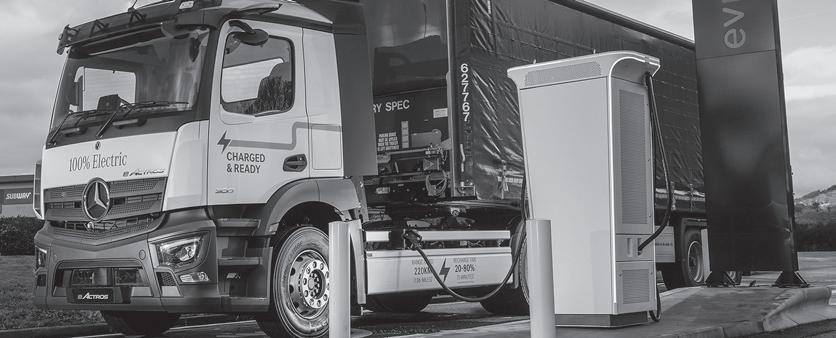
32
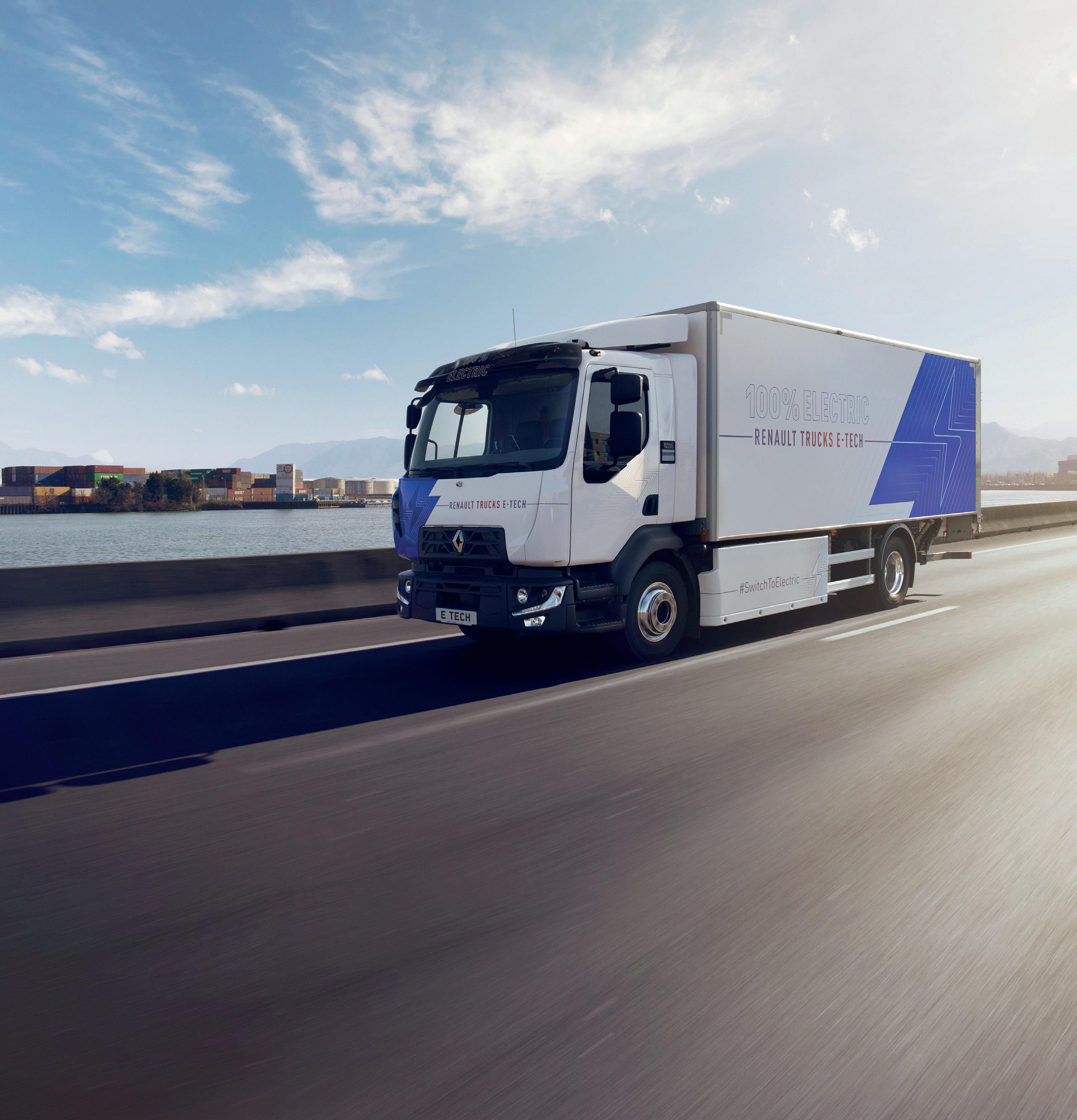

At Renault Trucks we are pioneers in electric vehicles. Our experience, and that of our expert partners, can help you introduce electric vehicles to your fleet, and reduce CO2 emissions to the benefit of us all.
At Renault Trucks we are pioneers in electric vehicles. Our experience, and that of our expert partners, can help you introduce electric vehicles to your fleet, and reduce CO2 emissions to the benefit of us all.
renault-trucks.co.uk
renault-trucks.co.uk

Kent’s Ashford International Truckstop, one of the largest in Europe, has been acquired by bp pulse: the UK oil giant’s electric vehicle charging arm. Bp pulse says the purchase is part of its drive to create a panEuropean network of truck charging stations.
Situated between Junctions 10 and 10A on the M20, Ashford International Truckstop is widely used by trucks crossing to and from mainland Europe through Dover Port and Eurotunnel.
The current owner, construction company GSE Group’s Ashford International Trucks Stop Ltd subsidiary will lease the site back from bp pulse, but the new owners plan to instal around 20 mega-watt chargers, plus ten 400kW and 125 100kW chargers, subject to grid capacity restraints and demand from operators. The first megawatt chargers are expected to open on site in 2026. These chargers can put up to 500 km of range into an electric truck in 45 minutes.
Currently, there is parking for 660 trucks at Ashford, plus facilities for drivers including a gym, which will continue under GSE management, while bp pulse manages the charging operation.
GSE Group chairman Darrell Healey said: “Our knowledge and experience of operating arguably the best truck stop in the UK combined


with bp pulse’s capabilities in building the EV charging infrastructure required by our existing and future customers is a perfect partnership. We’re looking forward to seeing our site evolve and serve E-trucks and to continue to explore other potential truck stop projects in the UK.”
Bp opened Europe’s first truck charging corridor in Germany early last year on 600 km of the Alpine – Rhine corridor. Arval pulse, bp pulse’s German brand, now operates 21 truck charging stations in Germany, serving 750 km of multiple routes. Bp pulse plans to link its German sites with a route of charging stations that will extend to the Ashford facility.
Alex Eftimiu, bp’s vice-president fleet Europe said: “Bp fleet solutions provide innovative energy and mobility solutions to help fleets of all shapes and sizes decarbonise today, tomorrow, together. Across Europe, we support 1.8 million fleet drivers providing fuels, charging and convenience offers across key logistics routes. This acquisition will be a great addition to our offering.”
EV charging is one of bp’s five so-called transition growth engines alongside convenience, bioenergy, hydrogen, renewables, and power.
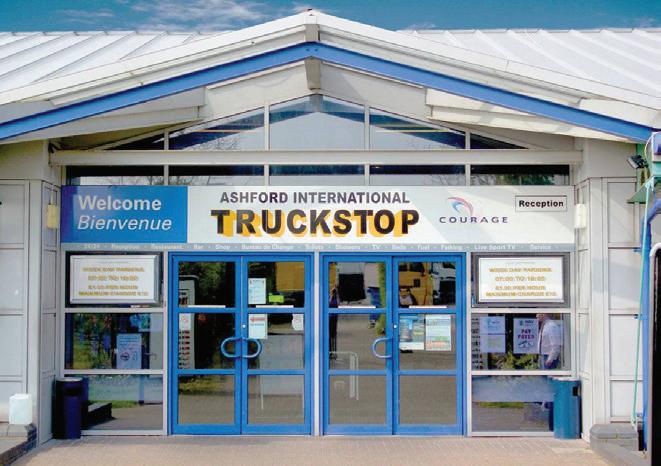
EV charging platform Monta and energy optimiser
GridBeyond have partnered together to deliver pioneering technology that transforms charging points into valuable resources, contributing towards grid stability.
Monta is an operating platform powering the EV ecosystem serving drivers, companies, cities, and the electricity grid with one integrated software solution. The partnership with GridBeyond aims at helping to reduce stress on the electricity grid.
Electric vehicle charging stations are often concentrated in specific areas, especially urban centres. This can lead to a situation where the local grid struggles to meet the increased demand, affecting not only the charging of EVs but also the overall stability of the electricity supply to homes and businesses. Grid contribution becomes pivotal during times of imbalance – either an unforeseen dip in power generation or a surge in demand across the local distribution network or the wider power grid.
By working with GridBeyond, Monta’s managed EV chargers will be used as valuable demand side assets in the Capacity Market and SFFR (Static Firm Frequency Response) programmes. By pausing all ongoing charges, the electricity demand is also reduced matching the pattern set by the imbalance, stabilising the grid and earning revenues from participation of these flexible assets within market. Monta customers opt into the service via Monta’s “PowerBank” product.
‘EVs have a huge opportunity to serve as a flexible asset to the grid if charging is managed correctly. We’re excited to partner with GridBeyond to deliver this pioneering service in the UK and Ireland.’ says Regional Director Alok Dubey www.gridbeyond.com

Waste and resource management company, RiverRidge has taken delivery of Northern Ireland’s first fully-electric skip truck: a Renault Trucks E-tech D Wide 18-tonner, equipped with Hyva skip-loader equipment and supplied by Diamond Trucks. It is is part of the company’s ambitious market-leading campaign to transition its fleet to zero-carbon engines within the next 15 years, and in so doing, reduce the carbon footprint of its transport services by 75%.
One of the main contracts the vehicle will be used on is with international ship builder and defence contractor, Harland & Wolff, where RiverRidge has secured a new service level agreement.
Scott Argue, waste management coordinator at Harland & Wolff, said, “As part of our Environmental, Social and Governance (ESG) strategy, we are keen to work with businesses and explore how we can lower our carbon footprint, creating more sustainable ways of working. The development of zero-carbon facilities will no doubt make a positive impact on our sustainability goals, and, at a time when our yard is buzzing with activity, RiverRidge’s technology is both incredibly useful and an important step forward in sustainable technology.”
RiverRidge developed a detailed ESG strategy, Rethinking Our Future, which launched in 2022 and against which it released its first annual
report in January 2024. The company has set out a comprehensive set of ambitions aimed at substantially elevating the sustainability of its activities across the entire group in terms of operational processes, employee well-being and community development. The strategy also includes the development of a more robust governance structure that amongst other things seeks to develop and maintain a sustainable supply chain.
Stephen Thompson, RiverRidge’s group transport director, said: “The addition of this vehicle to our fleet is one of a number of meaningful steps that the company is taking to meet the commitments we have made to all our stakeholders about reducing the carbon footprint of our collection services.”
RiverRidge CEO Brett Ross said: “Prior to the development of our ESG strategy, we consulted with a range of stakeholders to understand what they most want to see in terms of development over the coming decade. In almost every discussion, requests were made to address the environmental cost of waste and resource management.”
The truck will operate in the Belfast area with additional vehicles expected to be deployed across Northern Ireland over the coming years.



Hyundai Motor of South Korea and Iveco Group have expanded their partnership to explore synergies for electric heavy-duty trucks in European markets. Iveco recently launched its first battery-electric heavy truck: the eS-Way; which was developed in partnership with American start-up Nikola, but the letter of intent signed with Hyundai to develop batteryelectric and fuel-cell electric trucks for the European market would seem to indicate that its partnership with the US company has run its course. Iveco has previously worked with Hyundai in the production of the Iveco eDaily fuel cell van revealed at the IAA Show in September 2022, followed by a fuel-cell bus in 2023. It will also market an electric light commercial vehicle based on the Hyundai eLCV platform.
It unveiled its new Strategic Plan To 2028 and “Unlimited Pathways” for its five business units at its first Capital Markets Day, held this March.
Iveco’s powertrain business unit, FPT Industrial, is one of the top three independent engine manufacturers globally. Its focus on both internalcombustion engines and ePowertrains positions it for the shift towards alternative fuels and electrification, ensuring a sustainable and profitable future.
Gerrit Marx, Iveco Group’s CEO, said, “The first of our values states that ‘we go beyond the obvious’. It embodies the soul of our Group and

clearly reflects our ambition to consciously push limits and courageously set out on new pathways. We have demonstrated that we can fulfil the promises we make. Today we commit ourselves to a new plan, an acceleration of our product portfolio, stronger and more diverse partnerships, and a dial up our sustainability journey. We will deliver these commitments because the pathways and opportunities in front of us and our five business units are exciting and unlimited. Moreover, while we are drawing upon possibilities internally, we will continue exploring powerful opportunities outside. We will always go beyond the obvious.”
There are many forms of finance available to businesses today, but one of the most effective for companies wanting to invest in their growth without impacting cashflow, is Asset Finance.
Very simply, it’s a type of financing that enables businesses to acquire a range of assets, including those critical on our net zero journey.

There are several types of asset finance, including:
1. Hire Purchase is a product where the borrower agrees to pay for an asset in instalments over an agreed period, during which they are responsible for the maintenance and repair of the asset. When the agreement ends, the borrower has the option of purchasing the asset outright
2. Refinancing (Capital Release) is a quick way to access the cash from existing assets and using their value elsewhere – for example, to fund new equipment or ease cash flow
3. Sale and HP Back is a form of refinance where the lender purchases an asset and finances it back to the borrower. Repayments are calculated in line with the income stream that will be generated by the asset, and at the end of the refinance term, the borrower owns the asset
4. Finance Lease lets the borrower use equipment without having to buy it outright. Rent is paid to the lender for its full use, and the rental period is flexible and can be tailored, depending on requirements. During the rental period, the borrower pays the full cost of the asset, including interest
5. Operating Lease is a type of asset finance where the borrower rents the asset for a short period. At the end of the lease term, the borrower can choose to either return the asset or continue leasing it


• S.KOe Cool fridge trailer is now available in Britain
Schmitz Cargobull is launching its all-electric S.KOe Cool fridge trailer in the UK, two years after it was revealed at the IAA Show in Hanover, Germany The conventional diesel engine is replaced with an electrical generator in the centre axle, and this powers the fridge via a battery mounted in the location that would otherwise be occupied by the engine’s fuel tank.
Its fully electric S.CU ep85 cooling unit with integrated power electronics has 100 per cent emissions-free operation. The electrified semi-trailer is also extremely quiet, ideal for early-morning and late-evening deliveries in urban areas.
Colin Maher, managing director of Schmitz Cargobull UK & Ireland, said: “We are delighted to be able to introduce the fully electric semitrailer across the UK and Ireland, providing our customers with a truly sustainable solution for their temperature-controlled operations.” Already in operation for more than 50 customers across Europe, last year the S.KOe COOL achieved overall vehicle type approval by the German Federal Motor Transport Authority (Kraftfahrtbundesamt) after meeting all the relevant statutory safety, environmental and production requirements of the EU – making Schmitz Cargobull the first manufacturer to gain type approval for a fully-electric refrigerated semitrailer with an e-axle.
The S.CU ep85 cooling unit cools or warms cargo without generating any emissions, offering a cooling output of up to 15,800 W and a heating
output of 10,500 W. Batteries betwen the landing legs replace the diesel tank, and frees space for an extra pallet cage for 36 pallets. The payload is around the same as that of a refrigerated semi-trailer with a diesel unit with the additional weight of the battery almost completely balanced out by deleting the generator.
The electrified Schmitz Cargobull trailer axle recuperates energy during braking, extending the cooling unit’s operating time or reducing the time taken to recharge the battery via the power grid. This can reduce waiting times after loading. An intelligent charging management function ensures that the battery’s charge level remains as high as possible to provide greater reliability when the semi-trailer is stationary, such as in traffic jams.
Three pre-defined modes allow the semi-trailer to be optimised for the customer’s requirements. ECO mode ensures maximum energy and cost efficiency during refrigerated transport. STANDARD mode delivers costefficient protection against cargo spoilage, while SAFE mode provides maximum protection against spoilage. Modes can be selected via the display and keypad on the transport cooling unit or via the Schmitz Cargobull TrailerConnect telematics portal and app.
The generator performance of the electrified axle is precisely matched to the requirements of the cooling unit. It is fully integrated into the Schmitz Cargobull telematics set-up, enabling the system statuses such as the battery charge level, remaining range and charging time, to be monitored via the TrailerConnect portal.
“The journey towards a cleaner transport world has started. Join us
for Destination Net Zero
.”

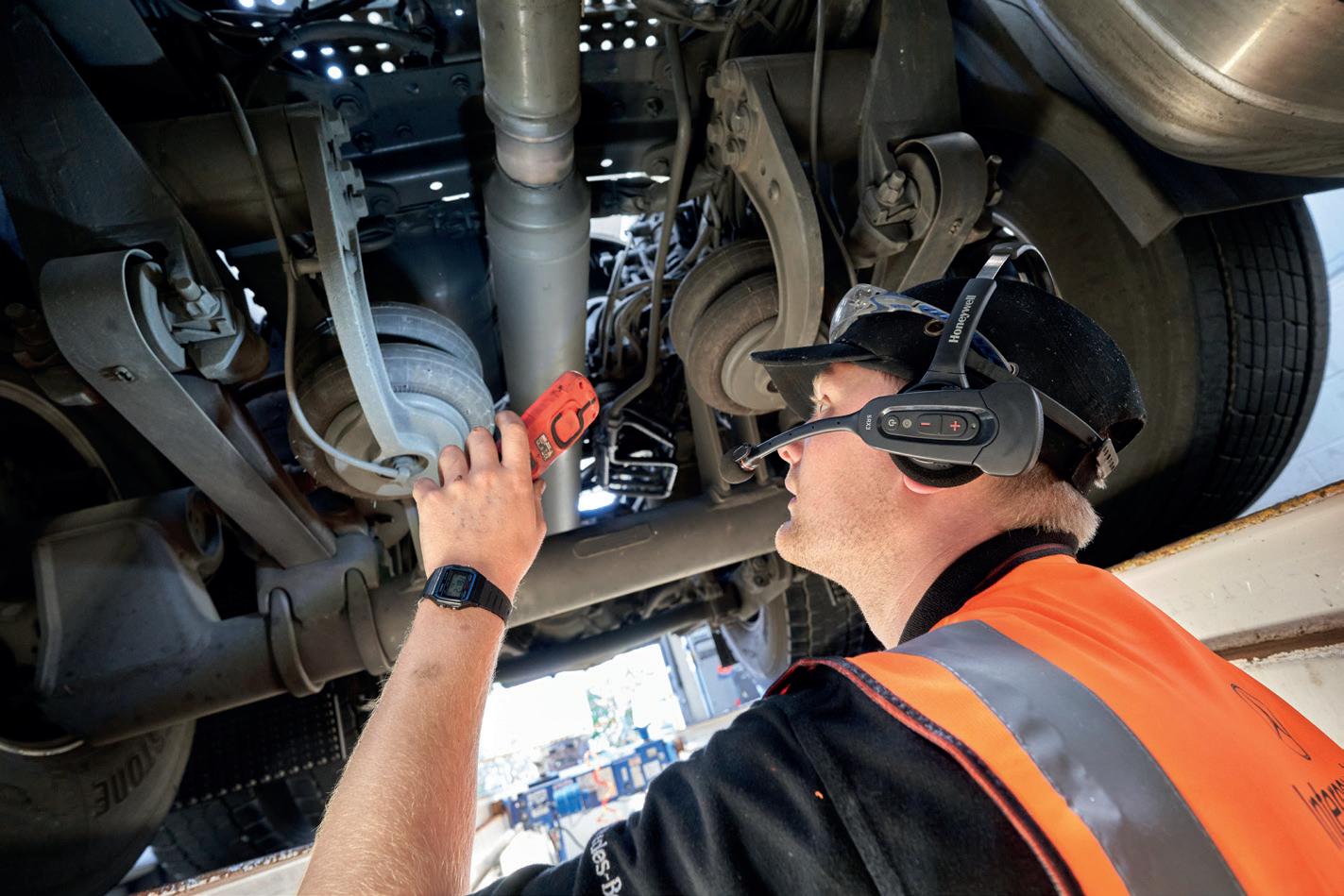

EVISIT: www.destinationnetzeromagazine.co.uk
“Efficiency has gone through the roof.”
“Our technicians love the new Voice solution and would never go back to how we were working previously. The depot is now functioning much more smoothly, safely and efficiently”
Steve Sargeant, Depot Manager of Intercounty’s site in Boston
Compliance. Done digitally.
Driver Check, Fleet & Workshop Management www.truckfile.co.uk

After a less than stellar start with the original eSprinter, it looks like Merc might have built an electric van worthy of the three-pointed star. Words: Greg Randall
From the shimmering seas of the Pacific coast to the rocky peaks of its Sierra Nevada mountain range, California has the highest saturation of electric vehicles of any US state. Los Angeles, the pulsating megalopolis with more than 18 million residents, is at the centre of the Californian EV economy with the majority of the state’s 1.4 million electric vehicles registered in the city. Electric vehicles currently make up 20% of all new vehicle sales but there’s still work to be done. Under the ‘no-gas mandate’, 35% of all new vehicles must be zero-emission by 2026. As a result, there are hefty incentives in place, from cash discounts to tax credits, to get people to go green and California has poured more than $1bn into companies that are electrifying the state with charging points.
California is certainly ahead of the curve compared to the rest of the country where just 7.6% of new sales are for EVs, and although cash payments and lower taxes sound like excellent reasons for Californians to switch away from fossil fuels, access to them is complex. There’s no hard and fast rule on who will get them and when it comes to a commercial vehicle not all businesses or owners will qualify. While California sounds like an EV paradise, and an ideal destination for the launch of the new Mercedes-Benz eSprinter, it’s no guaranteed homerun that the big Merc van will be a success, even in this clean-living state.
Mercedes, however, sees not just California but the US as a whole as a huge opportunity for the new eSprinter. This second generation of van has bigger batteries, longer range and a good deal

more power. It’s everything that EV customers are clamouring for.
The van itself is unchanged in style from the first model but the changes under the skin are significant, and there’s a greater choice of body styles too. What’s more it’s also now being built in the US with a hefty investment of €150m in bringing Mercedes’ plants in Charleston, South Carolina, as well as its German factories in Ludwigsfelde and Düsseldorf up to speed for this new generation of electric van. In total, the whole project has said to have cost Mercedes €350m. There’s no doubt then that the eSprinter needs to be a success, and the new van’s bigger batteries are certainly a key ingredient in their plans.

“Battery sizes have increased, with 56kWh, 81kWh and 113kWh batteries”
First launched with a 85kW motor and 55kW/h driveline borrowed from the eVito and in a single body size, the eSprinter gets far more options both with its powertrain and the vehicle configurations in its new guise.
Gone is the lonely option of a panel van wih high roof and standard wheelbase, replaced by a panel van or chassis cab available in two body lengths. There are now Pro or Select trim levels and Mercedes will also eventually offer conversions direct from the factory that will include dropside and refrigerated models.
Battery sizes have increased, with 56kWh, 81kWh and 113kWh batteries. Deliveries will start with the biggest 113kWh battery available at launch in the US, while UK customers will officially only get the choice of the top two batteries – largely because UK fleets never took a shine to the 55kWh battery size in the previous van – however, special requests for the smaller battery will be possible.
A big improvement has also been made in the chemistry of the batteries which are now lithium iron phosphate rather than the nickel-manganese-cobalt cells used in some Merc passenger cars. That means fewer rare earth metals, often sourced in dubious conflict zones causing tremendous harm to the local environment, are needed.
The batteries range in weight from 470kg for the smallest battery, up to 850kg for the largest. Mercedes has also increased the gross vehicle weight of vans with the largest versions to 4.25-tonnes to ensure that the payload can meet the requirement of all fleets with up to 1575kg possible.
Of course, a large battery means a big kerbweight and the 113kWh battery vehicle we tested in a warm and sunny Los Angeles weighs in at a chunky 3248kg. For that reason, it is only available at 4.25-tonnes GVW and because of the


physical size of the battery pack it only comes as an L3 length van. Even with the addition of 750kg to the plated weight, payload is just over one tonne. The flipside being that the large battery pack returns a huge number of miles with Mercedes’ own testing eeking out 475km (295 miles) in a long-distance drive between Los Angeles and Las Vegas on a single charge.
Officially, according to the WLTP figures it’s capable of 271 miles but in the real world with a payload it will likely fall closer to the 220-mile mark. Nevertheless, it’s a huge improvement from the 95-mile range of the previous model. Moreover, it’s now capable of genuinely fast charging, with speeds of up to 115kW on a DC supply. A charge from 10% to 80% will take just 42 minutes, or around 11 hours using a three-phase 11kW supply to charge it from flat to 100%. If you don’t have access to fast charging, it’s probably best to steer clear of this large battery model as on a single-phase 7kW supply the 113kWh battery will take up to 17 hours to recharge.
The eSprinter has had a significant interior upgrade with the introduction of the full MBUX system. Not only does that give you a digital dash display and central infotainment system, both with 10.25-inch screen, it also means there’s now Hey Mercedes voice control. It’s also got DAB radio, Bluetooth, and wireless smartphone connectivity. The entry-level Pro van gets heated electric mirrors, multifunction steering wheel, heated front driver seat, air conditioning and a reversing camera. There’s also a huge number of safety systems fitted as standard, the best of which include cruise control,



• There is now a wider choice of body and battery options
Blindspot Assist, Active Lane Keeping Assist and Intelligent Speed Assist.
An upgrade to the Select model adds a few nice-to-have features, but it isn’t the massive step-up in quality you’d expect from a top-end Merc. Instead, you get front and rear mudflaps, a leather steering wheel and a more comfortable driver’s seat. A fun little fact is that there’s also an upgrade to the cupholders. Larger, more Americansized, drinks holders are added in the position where the gearshift would normally be found, ready to swallow a Big Gulp 50oz soda – that’s a massive McDonalds takeaway drink, to you and I. The posh van also gets useful covered compartments in the top of the dash and LED headlights with automatic high beam assistance, or ‘dipping’, as we used to call it.
The old and new eSprinters share the same appearance but there’s a huge difference in the technology deployed under the skin. The new rear axle contains the electric motor, while new high-voltage components and control systems are in the front portion of the van. The battery packs are all housed under the floor in the centre of the van in a toughened protective case to prevent damage. Importantly, there’s also a lot more body sizes available. The eSprinter was originally only available in one size with a 11m3 capacity, but the new model will have a loadspace of up to 14m3 for the largest panel van. It also boasts a two-tonne towing capacity.
As the Sprinter is a bigger van with larger batteries you’d be forgiven for thinking that it might not be the quickest, but with 150kW, the equivalent of 201hp, the eSprinter is brisk. For our drive around LA we had a 200kg payload, which wasn’t really going to stretch the van’s abilities but the typical rear-wheel-drive Sprinter layout coupled with accurate steering and 400Nm of instant torque made it an entertaining van to drive.
Its ride is particularly good, delivering the sort of comfort you’d expect from a Merc, and its grip and stability on the road is improved over the ICE van thanks to its lower centre-of-gravity. It’s also surprisingly nimble for a large van, and devoured countless freeway miles in California with ease.
There are three driving modes: Comfort, Eco, and Maximum Range; that offer different characteristics. If you’re concentrating on maximising your range, then Maximum Range is the obvious (!) choice as it reduces power by 20%. Eco gives you slightly more go, and Comfort lets you have the full amount. There’s also Mercedes’ usual regenerative braking system, except this time it’s been improved with a new option called D Auto to add to the D-, D, D+ and D++ modes.


D Auto uses the radar-sensor to select the best of all the modes based on the traffic or the terrain so that when approaching stationary traffic and you lift off the accelerator it will automatically put it into the most severe mode (D-) to try and regenerate the battery and save you having to brake. It also works up hills, in much the same way as predictive cruise control does in a truck. As you crest the hill it will select D++ allowing you to coast down the hill. It takes the hassle out of selecting regen modes and on the whole works well to make your driving less stopstart when the regeneration kicks in. It has its moments of madness, so can’t be fully relied upon, but it’s a good new feature.
The new eSprinter is leaps and bounds ahead of the model of old, but the £73,260 (ex VAT) starting price means this really is a van for committed green fleets. That starting price, however, will come down as smaller battery models are added to the range. Perhaps most importantly of all, there’s finally a good alternative to the Ford E-Transit in the large van sector. •
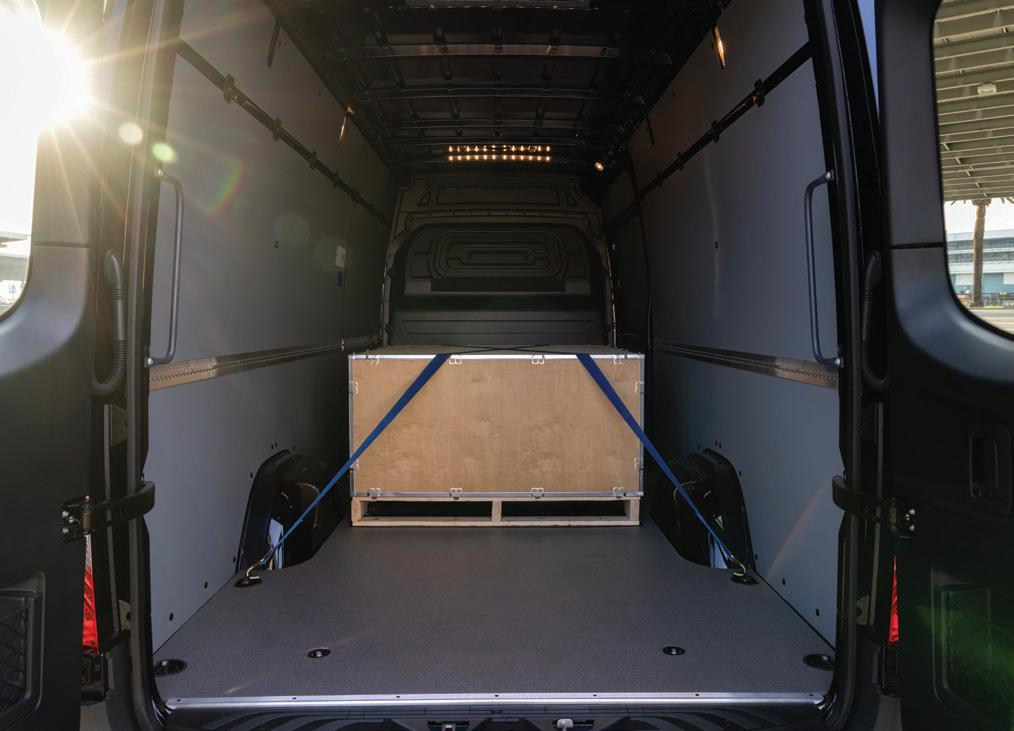



“gross vehicle weight of vans with the largest versions to 4.25-tonnes to ensure that the payload can meet the requirement of all fleets with up to 1575kg”
Grahame Neagus, Head of LCV, Renault Trucks UK

One thing is clear: 2024 is going to be a very interesting year.
The Zero Emission Vehicle (ZEV) Mandate, passed into law on 4th December 2023, sets out a clear roadmap to 2035 for 100% zero emission vans and provides welcome reassurance that the Government is committed to a zero emission future.
However, whilst clarity is certainly good news for the industry, we are faced with immediate and complex challenges. Most pressing of all is that if we are to achieve the 10% EV requirement for van sales in 2024, this must be matched by a surge in actual demand for EV vans from operators.
The danger, if the uptake of EV is lower than expected, is that our overall vehicle parc will grow older as operators hang onto their existing vehicles for longer or continue with diesel for one more cycle. Should this happen, and OEMs do not see the right model mix of EV/ICE as a result, we can expect to see lower overall ICE production in coming years to maintain the balance of this EV/ICE percentage ZEV Mandate seesaw. Not a great outcome for the consumer, the OEM, dealers or indeed the planet.
For the surge in EV sales to actually take effect, van customers need certainty. As well as the knowledge that EV is here and now, they need to know that their business is supported by the right public charging infrastructure in the right locations and at the right price per kW, with bays designed to accommodate larger commercial vans and trucks.
Now that electric tractor-units such as the Renault Trucks E-Tech T are on our roads, the need for a reliable public charging infrastructure provision for commercial vehicles has become increasingly important.
Operators need to plan their routes and know exactly when and where their drivers will be able to recharge their vehicles.
However, when it comes to on-road charging, this HGV-orientated infrastructure does not exist in the UK today, meaning operators are restricted largely to back-tobase routing. More needs to be done by the government to give operators clarity on where and when it will be ready, otherwise uptake will continue to be slower than we all want. A nationwide, robust charging infrastructure will make electric mobility more attractive – and make our ZEV Mandate requirements more achievable.
A further area that needs urgent attention if we are to achieve ever increasing percentages of EV sales is the rise in insurance costs, which is being driven by a blend of higher repair costs, time to repair, and a cautious approach to the integrity of the repair. Public sector and large International businesses, many of whom are self-insured, will simply absorb the EV product into their fleet insurance. However, for SME clients, increased insurance costs could be another barrier to EV adoption.
Following on from this, we also need to ensure that we have enough fully-trained technicians to maintain UK plc’s growing EV fleet. If you look at the overall number of circa 22,000 commercial vehicle workshops in the UK and the ever-increasing volume of EV products, technicians will be key to ensuring the continued growth in BEV, and hydrogen fuel cell powered vehicles. The main OEM dealer networks have strategically designed training courses to ensure the technicians are fully capable of maintaining the vehicles of today and tomorrow, but what of the independents,
bodyshops and in-house workshops, let alone the bodybuilders and converters?
Many of the independents and bodybuilders have been, up to this point, slow to undertake the training required to correctly and safely work on the new powertrains. Adaption to the brave new world is not an option but a mandatory requirement.
The Government’s roadmap sets out the journey for vans, but also is creating unease at the prospect of the market’s desire to keep growing at the same pace. One thing that is definite is that customers understand their own operations better than anyone, they know what works and what doesn’t, and they certainly won’t appreciate anyone trying to impose their will on them.
For OEMs, the temptation – and folly - of pre-registering hundreds if not thousands of EV vans just to avoid huge fines simply kicks the can down the road. The ZEV Mandate for vans states that we have to achieve 16% EV sales in 2025, and 24% by 2026. Education, infrastructure and support of our marketplace is what’s needed and at a pace that can be sustainable for the greater good of all.
Much can and should be learnt by similar industry sectors on similar trajectories to a cleaner future, such as agriculture, materialhandling and construction equipment. For these industries, the move forward has been at a pace as new models are introduced and the active use of data is transforming the way people work and the equipment they use.
Yet despite some of these challenges, the good news is that we are seeing growing interest in and adoption of EV models, as operators understand the landscape better.
“The ZEV Mandate for vans states that we have to achieve 16% EV sales in 2025, and 24% by 2026.”
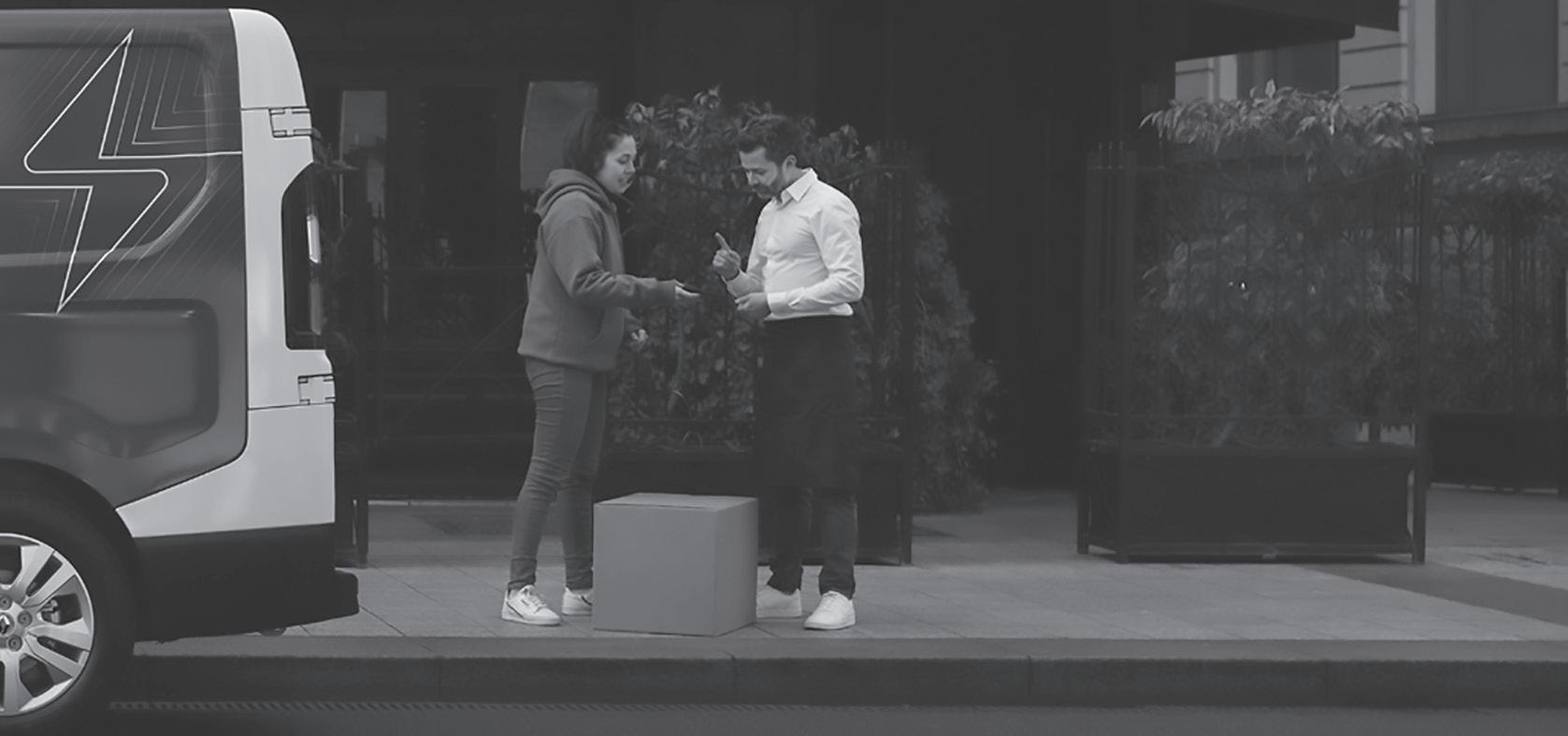

• Grahame Neagus
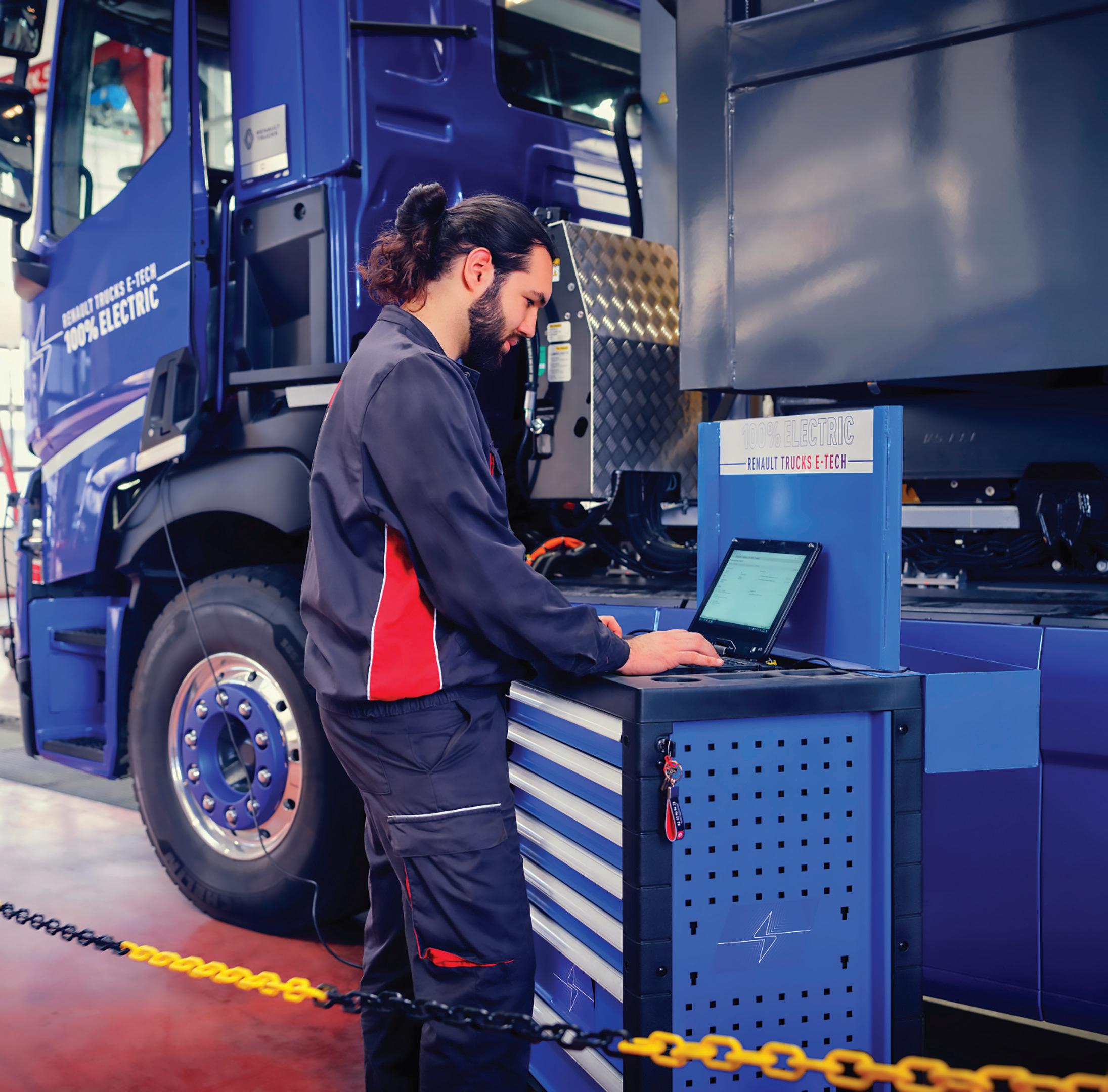

In the race to slash carbon emissions, European truck manufacturers are increasingly bringing new trucks to market that offer operators an alternative to diesel-fuelled road transport. All the major OEMs – and some new start-ups – are beavering away with battery electric trucks that promise zero-emission deliveries for companies looking to lower their carbon footprint. Some are further along than others, but Volvo Trucks is right at the front with its offer of no fewer than seven electric truck models spanning light-, mediumand heavy-duty specifications (eight if you include the VNR Electric for the North American market).
Its latest release is the FH Aero Electric, which has a new streamlined cab with a range of improvements that combine to produce “our most efficient truck ever”, according to Volvo president, Roger Alm.
Unveiled at the end of January, FH Aero Electric makes use of the revised 2019 EU Masses & Dimensions regulations which permit longer cabs. This enable the front of the cab to be extended by 240 mm compared to regular FH to create a sleeker aerodynamic profile. Cab options are low sleeper, sleeper, and Globetrotter in standard and XL forms.

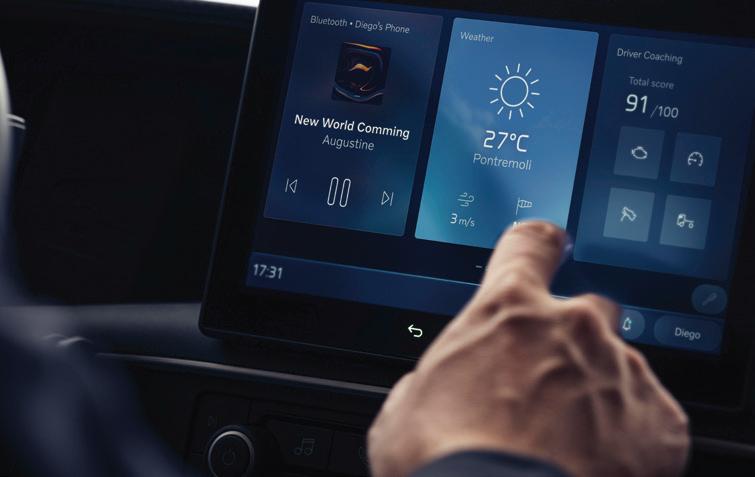


Corners have been rounded off to ease air flow around the truck. Gaps between panels on the cab front and leading into the engine bay have also been sealed off, and gaps have been reduced between the truck and trailer body. The top of the cab has been made a bit sleeker to aid the flow of air up and over the vehicle.
Volvo claims these tweaks give Aero an 11% aerodynamic efficiency improvement for a standard tractor/trailer combination compared to regular FH.
Axle configurations are 4x2, 6x2 and 6x4 for tractor units; and 4x2, 6x2, 6x4, 8x2 and 8x4 for rigids. All axles are air suspended. GCW is up to 44 tonnes.
In terms of battery capacity, FH Aero can carry 4-6 battery packs to give between 360-540 kWh of power. Range is quoted as being up to 300 km for a 4x2 tractor unit and standard trailer. Charging time from empty to full is 9.5 hours with AC (43 kW), and 2.5 hours with DC (250 kW).
The driveline is made up of Volvo’s super-smooth I-Shift gearbox mated directly to either two or three electric motors. This arrangement gives up to 330490 kW of continuous power.
A new, enlarged Volvo badge sits low down on the Aero, which offers operators a decent space to use for signwriting. A fresh grille design features a striking grid pattern. Additionally, the integrated front step is large enough to not only be good for windscreen cleaning, but also doubles up as a spacious bench complete with handy cup holder. Internally, the changes are subtle. The dashboard remains largely unchanged, save for a few additional USB ports. However, a new key fob features a pre-trip lamp inspection function to cont.


“FH Aero Electric makes use of the revised 2019 EU Masses & Dimensions regulations which permit longer cabs.”
activate lights, and Volvo said keyless start will soon be mandatory for electric trucks.
The audio system has been upgraded and is available in two versions: Selected or Extended. Both feature six high-quality speakers, while the Extended system boasts a new power amplifier and a powerful subwoofer for a more immersive experience. Infotainment software has been tweaked, with the driver-side display now offering customisable widgets and the ability to save presets for individual drivers. The Navigation app not only calculates trips based on the vehicle’s profile and load, but also provides better notifications for speed cameras, sharp bends and other road hazards. Map updates are conducted over the air, so downloads can be triggered remotely.
A dedicated My Truck smartphone app gives drivers control over cab climate settings, door lock status and alarm checks. Additionally, it provides real-time monitoring of lights and battery charging status. Drivers can also use the app to pre-condition the cab climate ahead of their shifts to ensure a comfortable start to their journeys.
An important part of FH Aero Electric’s aerodynamics is Volvo’s new Camera Monitor System (CMS), which replaces conventional mirrors with rear- and downfacing cameras feeding screens in the cab. CMS cameras reduce drag as they present a slender and smaller frontal area than mirrors.
The passenger side CMS display measures 15 inches, while the screen nearest the driver is 12 inches to improve visibility around the A-pillar. Buttons beneath the driver’s side screen are used to control camera heating, panning and brightness, while other camera adjustments can be found on the door sill.

CMS has a ‘Zoom Out’ function which gives a wider view at the touch of a button. It also features automatic panning so the end of the trailer is always in view. The system uses fixed panning when reversing, with three options: normal view, wide (18 degrees wider) or extrawide (even wider still). A security mode enables drivers to check around the truck via the monitors when parked up. This can be activated via mirror controls or the control panel near the bunk.
CMS can be spec’d with Corner View, which replaces front/kerb mirrors with a down-facing camera fed to the driver info panel on the centre console. This automatically appears when indicating left on right-hand drive models, or right on LHD.
Volvo has also worked hard to alleviate that common driver complaint for digital mirrors: namely, low-light performance. CMS uses infrared sensors built into each camera arm

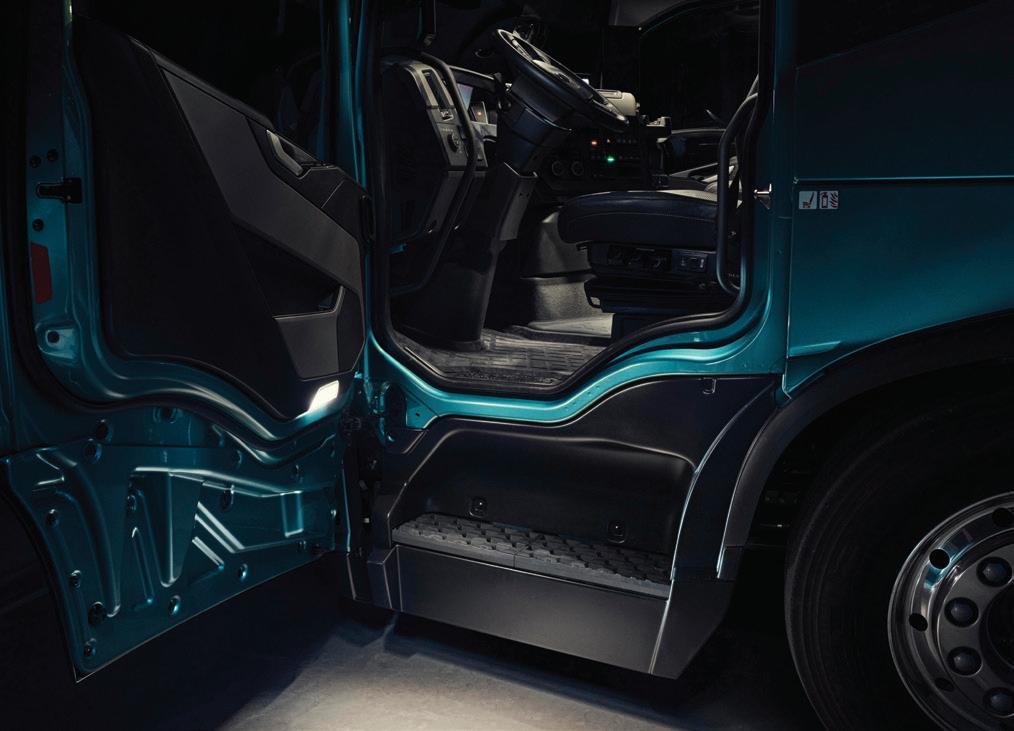

•
which Volvo claims makes performance in low-light and pitch-black conditions almost as good as daylight. In fact, the darker it is outside, the clearer the image will be, according to the manufacturer.
Volvo has upgraded its safety technology for its latest models. Side Collision Avoidance Support (SCAS) employs radars on both sides of the truck to alert the driver of nearby road users or pedestrians. A new feature, Door Opening Warning, maintains SCAS for two minutes after engine shutdown and warns if a road user is detected when the door is opened.
Intelligent Speed Assist (ISA) utilises the front camera to read traffic signs and provide speed limits, overtaking restrictions, and height
limitations to the driver via the dashboard.
ISA now displays the permitted speed limit for the specific vehicle combination and issues warnings for overspeeding. Map data supplements ISA accuracy and provides advance notice of upcoming speed limit changes. Additionally, the software automatically converts between miles and kilometres based on the truck’s location.
Pilot Assist acts as an enhanced Lane Keep Assist, using a front camera and Dynamic Steering to maintain lane position. It enables I-See cruise control to navigate corners, bends and roundabouts without disengaging. An alarm triggers if hands are removed from the wheel, with escalating warnings leading to a full halt with hazard lights activated if hands are not detected after 45 seconds.
Also launched is the new FM Low Entry (FMLE) – the first Volvo truck to be exclusively available with an electric powertrain. Designed for urban and municipal tasks such as refuse collection where visibility and cab accessibility are paramount, FMLE is powered by four battery packs and two electric motors. It uses a shortened FM crew cab which has been positioned 500 mm forward and 250 mm downward, putting the driver at eye level with pedestrians and other road users.
FMLE is aiming for a five-star DVS rating at launch and includes a completely flat floor, achieved by spreading out high-voltage components, along with the option of a twoor four-seat set-up and an interior height of up to 1945 mm. CMS can be fitted as an option.
FMLE is rated up to 32 tonnes and can be spec’d with two, three or four axles. Dynamic Steering is standard across all FMLE cabs for better manoeuvrability, while wide doors and a single step keep cab access nice and easy. A kneel function can also lower the cab by an additional 104 mm if necessary.
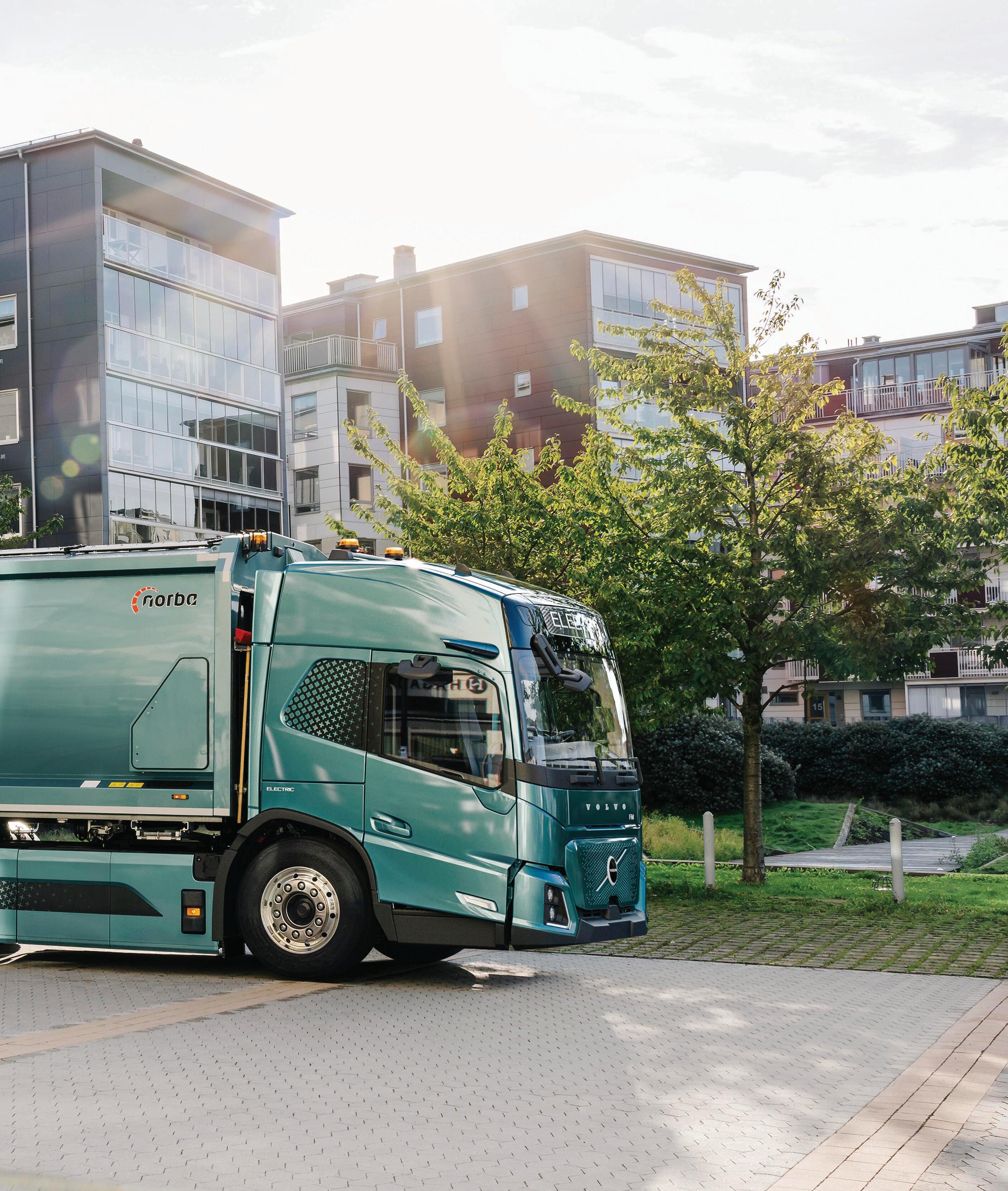

“A new feature, Door Opening Warning, maintains SCAS for two minutes after engine shutdown and warns if a road user is detected when the door is opened.”
Switching to retread truck tyres can help transport fleets shrink their carbon footprint and reduce their impact on a planet under growing pressure, says Bridgestone. Words: Steve Banner
that
around three-quarters of the material used to make a new tyre is reused when a retread is created with 32kg of rubber and 14kg of steel recovered from the old tyre?
“It’s a good example of the circular economy at work,” says Andrea Manenti, Bridgestone’s north region vice-president responsible for the UK and the Republic of Ireland.
Nor are these the only environmental advantages, the manufacturer stresses. Building a retread consumes up to 70 litres less oil than making a new tyre, and up to 80% less CO2 is emitted while it is being manufactured.
Any suggestion that retreads are a poor substitute for new tyres should be dismissed, Manenti insists.
“Inspection processes such as shearography, nailhole detection and inflation testing have resulted in quality retreads that are every bit as good as new tyres,” he says. “There are multiple inspection stages making the quality checks on the finished product as comprehensive as they get.”
Working in a similar way to an ultrasound scan, shearography analyses the tyre’s core structure in order to identify any faults that may be hidden under the surface.

To demonstrate its commitment to retreading, Bridgestone is pumping almost £5m into its retread factory in Bourne, Lincolnshire in a three-year investment programme. It is reshaping the range of tyres the plant produces at the same time.
Until recently pre-cure retreads accounted for 60% of Bourne’s output. The difficulty was that UK hauliers much prefer hot-cure retreads, which make up four-fifths of the market; so Bridgestone was missing a trick.
The reason is not hard to fathom.
Back in 2009 Bridgestone bought US-based retreader Bandag and still uses its brand-name. Bandag based its business on pre-cures, which explains the bias in favour of them until now.

“Building a retread consumes up to 70 litres less oil than making a new tyre, and up to 80% less CO2 is emitted while it is being manufactured.”
That bias has come to a halt with Bridgestone’s launch of a new hot-cure range under the Bandag Hotread banner. Seventeen new hot-cure variants will arrive this year, with eight already available. The line-up includes the R-Trailer 002 trailer tyre as a 385/65 R22.5 and the R-Drive 002 drive-axle tyre in a line-up that includes 295/80 R22.5, 315/70R22.5 and 315/80 R22.5 sizes.
“We’re growing the hot-cure range and we’re retiring some of the pre-cure products,” says Bridgestone service operations business partner, Mike Howling.
The new crop of hot-cures delivers better performance than the previous offerings says Bridgestone. According to tests the manufacturer has conducted itself, the R-Drive 002’s rolling resistance is up to 25% lower than that of its M730 predecessor.
The increased emphasis on hot-cure is reflected in the new equipment the factory has acquired. It includes eight additional hot-cure presses and a new hot-cure rubber extruder.

The swing in favour of hot-cure has been rapid. Pre-cures had fallen to 40% of factory output at the time of writing, with hot-cures now dominant.
So what’s the difference between hot-cure and pre-cure?
With a hot-cure, new rubber is applied to the circumference of the casing which is then placed in a press which moulds on the tread pattern. It does so at a temperature of 155 degrees C maintained for up to 90 minutes.
With pre-cures, ready-formed treads are applied to casings using an extruder/builder. Once the tread has been applied the tyre is placed in a rubber bag, all the air is evacuated from the bag, and the tyre is cured in an oven at 115 degrees C for four hours.
Hot-cures have a more attractive appearance than pre-cures, and can be difficult to


distinguish from their new equivalents. They may be a little cheaper too.
Pre-cures are said to last longer because of the density of the tread rubber employed. The lowertemperature process can also place less stress on the tyre carcase.
The plant’s new machinery is more productive than existing equipment says Bridgestone, and not as CO2-intensive. Says Manenti: “There’s been a big focus on making retreads more efficiently, with reduced energy consumption.”
At present the factory makes 70,000 retreads annually. However the total could increase to up to 100,000 a year over the next five years, the company predicts, as demand for Bandag Hotreads rises.
In 2022 alone Bourne recycled 4,400 tonnes of scrap tyres and 520 tonnes of rubber dust says Bridgestone. This equates to savings of 4m litres of oil, 2,000 tonnes of rubber, 900 tonnes of steel and almost 4,000 tonnes of CO2 emissions compared with the equivalent production of new tyres, it claims.




Running on retreads can contribute to shrinking tyre costs per kilometre by almost one-third compared with relying solely on new tyres, Manenti contends. He is conscious however that cheap new tyres with unfamiliar names shipped in from the Far East are competing aggressively with Bridgestone’s retread portfolio.
Such tyres tend to be single-life only, says Bridgestone, and are not usually suitable for retreading. By contrast, a premium new tyre from manufacturers such as Bridgestone, Michelin, Continental and Goodyear can potentially be retreaded twice if it has been properly maintained.
“We firmly believe that retreads have got to replace cheap imports,” Manenti states.
Boosting the benefits of retreads is in tune with Bridgestone’s professed aim of achieving greater sustainability in everything it does.
It wants the entire group to use 100% sustainable materials and be carbon-neutral by 2050, and intends to boost the share of recycled and renewable materials in its tyres to 40% by 2030. It is also working with

Michelin to increase the use of recovered carbon black in new tyres.
As things stand less than 1% of all the carbon black used in new tyres produced globally comes from recycled end-of-life tyres says Bridgestone. Increasing this percentage will reduce the industry’s reliance on petrochemicals.
Fleet operators tendering for work may find using retreads gives them an edge when they are completing the tender document.
At some point they will be asked what they are doing to shrink their carbon footprint and become better stewards of the environment. Running on retreads can form part of their answer.
end

“As things stand less than 1% of all the carbon black used in new tyres produced globally comes from recycled end-of-life tyres says Bridgestone.”

KING®, a leader in transport temperature control solutions and a brand of Trane Technologies, announced today the next step in launching their fully electric E-Series designed for electric light commercial vehicles (LCV). The company is starting the production of the new E-500e single and multi-temperature models for fleet operators looking for electric edge in inner city and urban deliveries.
“With the E-500e model, we deliver an allelectric solution that extends the limits of what is possible today, and help our customers do the same,” said Davide Fusciani, product manager Thermo King. ”The E-Series is not only 100% electric, but also energy-efficient at heart, with an unmatched cooling capacity and an ideal use for urban areas.”
“For this model, we went back to the drawing board, keeping our customers’ and the environment’s needs at heart. With the European Union calling for CO2 emissions from new trucks to be cut by 90% by 2040, we give our customers solutions that help them align with this transition and future proof their operations. We are now starting the production of the E-500e single and multi-temperature units, and more models will follow,” said Davide Fusciani.
The E-500e is designed to extract the full
• New model in the flagship E-Series range for urban and inner-city deliveries
• 100% electric powered for seamless operations with e-LCVs
• Highly efficient and sustainable solution to reduce carbon emissions
potential of electrically powered refrigeration while ensuring the lowest possible impact on the battery and range of the electric vehicle. Custom-designed inverter technology, a patented power control system and real-time communication between the unit and the vehicle maximise the cooling performance, energy efficiency and optimal power supply with minimal impact on the vehicle’s autonomy.
The E-500e is powered directly by the vehicle’s battery, eliminating the need to invest in an additional battery pack or shore connection module. Drivers can keep their refrigeration unit running while their battery electric vehicle (BEV) is charging or stationed at a delivery stop.
A brand-new, high-speed compressor with RPM independent of the vehicle’s speed generates new levels of electric cooling capacity up to 4.5 kW and both cooling and heating modes to fit customers’ multiple application needs.
The E-500e is fully compliant with LEZ, ULEZ and ZEZ emission zones, as well as diesel-ban areas leading the way to flexible and efficient operations with day and night access into any city centre.
The units are easy to install on panel vans, chassis cab trucks and other types of vehicle conversions thanks to the compact design, which delivers high performance with half the weight of an equivalent legacy unit. Lower weight means a reduced impact on the battery-electric vehicle’s range and maximizes the vehicle’s payload, increasing operational flexibility and bottom line.
The new E-Series unit is designed to answer the challenges of e-LCVs and inner-city deliveries such as how to keep temperature control performance high with minimal energy consumption, how to offer cost-effective solution to a high investment choice, and how to reduce the refrigeration unit’s impact on the range of the BEV. The E-500e translates these challenges into a highly efficient and sustainable solution.
Providing electric solutions for refrigerated transportation is part of Thermo King’s and Trane Technologies’ overall approach to reducing carbon emissions. It aligns with the company’s bold 2030 Sustainability Commitments, including the Gigaton Challenge to reduce customer greenhouse gas emissions by 1 billion metric tons.
For more information on Thermo King solutions, please visit www.europe.thermoking.com





With E-Series, Thermo King hits the town with a new, all-electric refrigeration unit for electric light commercial vehicles. With energy e ciency at the heart of the new design, it’s built to bring out the best in electric performance, and deliver it straight to the city center.


As we enter a new year, perhaps it’s time to take a step back and look at where we are in our transition to emission-free van operation, what we’ve achieved, and what we need to do.
The ZEV (Zero Emission Vehicle) Mandate – much talked about and, as of January 1st, now here with us – will be shaping our year ahead. To recap: in 2024 10% of LCV registrations must be zero-emission with all van manufacturers having to pay £9000 per vehicle for any shortfall. Things tighten up after this with the percentage gradually rising, and the fine doubling to £18,000 in 2025. Some manufacturers are already achieving the 10%: notably Vauxhall who will quite possibly be able to give/sell/trade any over-performance to others (more than likely to fellow Stellantis group companies, some of whom are not doing so well). But look at market leader Ford – granted, it has some new product coming along but, in December 2023 of the 7837 vans it registered, only 38 were electric. A product problem perhaps? Unlikely as there’s not much wrong with the E-Transit which has been with us for a couple of years now.
Whilst we hit over 20,000 electric van registrations in 2023, the market share of electric LCVs of 5.9% was exactly the same as in 2022 so, the reality is zero growth in percentage terms (numbers were up substantially, but just as they also were for diesel vans). There’s a big job to do and if I’m honest, I suspect that some manufacturers will already be looking at the transitional contingency measures of borrowing and deferring against future registrations that the Department of Transport have put in.
Short of a sudden upsurge in demand, the only other tools they have up their sleeves would be distress marketing with huge discounts (we’ve seen this already and it doesn’t do anyone much good and gives those who have previously set future residual values sleepless nights), reducing or eliminating the pricing gap between diesel and electric (expensive, however it is achieved), or reducing output of diesel (which would stress the market horribly!).
Fleet operators have so far been the backbone of EV adoption, taking on vans where they will work for them (and in some cases where they wouldn’t, in a rush to tick a box). These customers have been ‘flogged to death’ by manufacturers, and it’s certainly now time for the focus to be placed on SMEs. Harder work but really the only avenue for continued growth!
There’s another challenge to be faced. Used electric vans are not proving popular with trade buyers, who are not seeing demand from customers so are reluctant to buy for stock. If they’ve got £50,000 to spend, they would rather buy five popular diesel vans, knowing that they will turn a profit within a few weeks than speculate on the relatively unknown of a BEV and risking losing money in order to move it on to get some cash back in the bank.
So, as a consequence, values are low and those forecasting residual values to asses future risk are nervous. We’ve already seen some huge reductions from trade price guides which previously assumed demand would be healthy. The further
consequence? Lease rates then rise making the electric van costly to acquire and so fleet managers and SMEs alike are left with little choice but to opt for the cheaper diesel. This then brings us back to the manufacturers, desperately trying to achieve that 10% target…
As it stands at present, and for a number of reasons, an electric van won’t be ideal for all operators and applications. Although the ranges available on a full charge are steadily increasing, we’re not yet at the 300+ miles that some electric cars can achieve, and some van buyers believe they need. Payloads are generally lower than an equivalent diesel van (without moving to the 4.25t variant and navigating the differences demanded by special legislation). Furthermore, some manufacturers are restrictive in the models offered in comparison to the diesel range (lengths, heights etc).
All this is fair enough but, in many circumstances, these objections are being misunderstood with urban myths being propagated by the cynical and stubborn. What we need is education, and alongside that, to get bums on seats.
I’m not going to beat dealers with a stick as the sales staff rely on training and from what I have seen this is focused on the product and not the wider context we are in. Let’s get the teams fully geared up, so that they’re knowledgeable, transparent, that they accept any limitations of an EV showing the customer credibility, and so they can qualify him or her correctly whilst at the same time handling objections.
“It’s not just down to manufacturers and dealers – all in the industry have a part to play.”

Customer: ‘It’s no good to me, that 174 mile range will be down to 100 with the weather and a tonne of sand in the back’.
Dealer:‘How many miles do you cover in a week?
Customer: ‘No more than 10 a day, I work locally’…
Customer: ‘My 3.5t Transit carries 1.3 tonnes. One tonne won’t work for me.’
Dealer: ‘How about 1.7 tonnes then*?’
Customer: ‘What? Really?’
(*Obviously, the sales consultant would need to explain the restrictions of the 4.25t dispensation)
Bingo – changing the conversation with knowledge and patience.
Equip the dealership with a reasonable number of demonstrators and let the customer use the van for a day or two in their own operation. This may need
manufacturer support, but if ultimately the programme reduces those £9000 fines…
Last year, the Commercial Vehicle Show in Birmingham was very well attended. By visitors. But where were the manufacturers? According to my count, there were only five mainstream ones. Fair play to Ford Pro, with its massive stand in a prime spot with a big display and plenty of knowledgeable staff and also Maxus with an excellent showing, but where were the Stellantis companies?
Also missing were Mercedes-Benz (who haven’t been there for a few years), Volkswagen, Renault and Toyota. This is a huge opportunity to showcase their vehicles, the exposure also providing a large number of PR opportunities.
Fingers crossed the 2024 show will see an increased commitment from van manufacturers, especially as there is a fair bit of new and improved product since
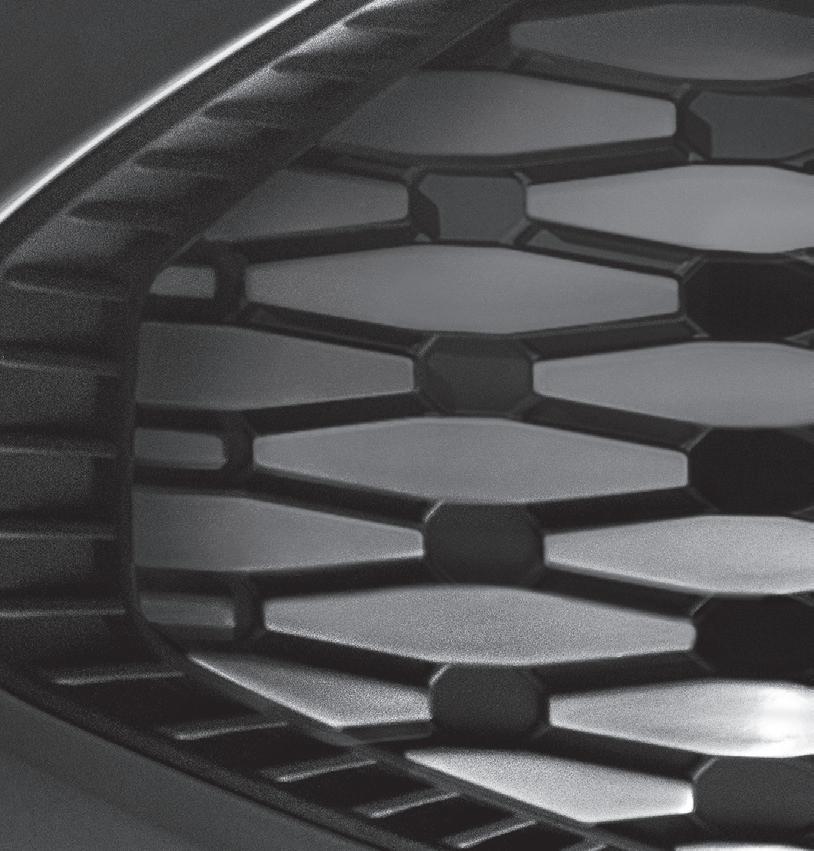

• Paul Kirby
last year. Even The EV Café will be there to provide a platform for electric vans and the EV ecosystem – come and see us. And yes, these things cost, but so does missing the targets. Remember, the show is FREE to attendees!
It’s not just down to manufacturers and dealers – all in the industry have a part to play. There needs to be improvements in charging infrastructure for commercial vehicles, and those involved need to work together with a common aim. Industry bodies need to continue to lobby the government for support (Watch this space!), both in policy and fiscal terms. Fleets need to be open minded and look for the possibilities – the “low hanging fruit”. Ultimately the Road to Zero is something we all should be supporting, and everyone needs to work together to make our air cleaner, to provide a healthier environment for all and to give our drivers vehicles that are easier to drive, safer and nicer places to be! #getstarted
Paul has over 30 years of automotive experience, focused on Commercial vehicles. His passion for the electrification of the Van sector is widely recognised. He now runs his own Consultancy, Media and Training business, EV Essentials Ltd, and is also a founder member of The EV Café team. His main aim is to help fleets get started on the transition to an electric/zero emission fleet.
Paul Kirby on LinkedIn: www.linkedin.com/in/thepaulkirby/ The EV Café on LinkedIn: www.linkedin.com/company/theevcafe/ Paul Kirby on YouTube: @electricvanman / www.youtube.com/@electricvanman
The weather is against it, so will the new Mercedes distribution truck flatter or just fall flat?. Words:
Adam Fairbrook
Mercedes-Benz’s
expanding range of battery-electric trucks is intended to serve a multitude of sectors:
eActros 600 is being readied to tackle extended journeys of up to 500 km per charge, while eEconic is aimed at lowmileage municipal workloads. Sitting in between the two are eActros 300, and eActros 400, which are for shorter-haul missions.
The eActros 300 LS has a claimed range of 135 miles (220 km) on a full charge. Its remit is regional distribution – such as multiple local trips between depots without travelling too far away from base.
To make things a bit more exciting for this test drive, the plan was for us to drive eActros along the motorway from Merc’s Wentworth Park HQ in Tankersley to the newly installed truck fast-charger at
Rivington Services. There, we’d top up the batteries during a short break before heading back. Totting it all up, we were looking at a round trip of about 160 miles.
Our cargo would be 12 tonnes of concrete – half the truck’s 24-tonne overall payload potential with a standard trailer – meaning we’d be grossing 28 tonnes overall.
Based on a 4000 mm 4x2 chassis, the eActros is slightly longer than a diesel equivalent because it needs some extra space for its three 112 kW/h battery packs (97 kW/h usable) –which combined totals 336 kW/h (291 kW/h usable) capacity.


Mercedes’ rear eAxle is powered by two motors producing 330 kW (equivalent to around 443 bhp) of continuous power and 400 kW (536 bhp) peak. The eAxle uses a two-speed automatic transmission with two forward and reverse gears. Also installed was the latest version of MirrorCam and Merc’s wide range of safety systems, including Active Brake Assist 5, Attention Assist, Lane Keeping Assist, Stability Control Assist, Traffic Sign Assist and Proximity Control Assist. To be honest, we were quite glad of these as the weather was awful – very strong winds and torrential rain were already in full swing when we climbed into the driver’s seat.
The air-suspended ClassicSpace 2.3 m wide M-Cab will be familiar to anyone who’s driven the diesel version. Inside is Merc’s 12.3-inch MultiMedia Cockpit with central dash-mounted infotainment screen, though this is augmented with a few extra screens detailing energy flow and battery charge level. At the start of our run, the truck was charged to 84% – plenty to get us to Rivington, despite the harsh headwind and driving rain.
One thing we always notice with electric trucks is how quiet they are in operation. There’s only a slight whine from the motors when pulling away. To say it’s peaceful is an understatement – the quiet cab makes for a very relaxing drive.

The eActros is also very comfortable. Its driving position feels spot-on and the truck responds very positively at junctions and roundabouts, largely thanks to an abundance of torque from the eAxle.
There are three driving modes: Power, Economy and Range. We selected Economy for our drive because of the weather conditions, which limits us to 53 mph. Power mode goes to 56 mph, while Range is limited to 51 mph to ensure maximum driving distance.


“Mercedes’ rear eAxle is powered by two motors producing 330 kW (equivalent to around 443 bhp) of continuous power and 400 kW (536 bhp) peak.”

Threading our way out of Merc’s HQ, we joined the M1 towards Leeds, engaged cruise control and settled back for a smooth ride. Before long we picked up the M62 to Manchester, which would carry us past Rivington southbound – so we’d need to spin around at the next junction and double back a few miles before we could make our stop.
The wind and driving rain battered us all the way and it proved a good real-world test for eActros. We didn’t shy away from pumping up the heating, air con and demisters either, putting further strain on the batteries – but regardless, the truck took it all in its stride.
eActros uses regenerative braking to reduce speed while descending hills and it works in a similar way to an engine brake. It has five stages, with stage three proving versatile for most things. However, stages four and five really dig in, which is good to know in case you have to react quickly to traffic conditions.
Regenerative braking puts energy back into the batteries, so it’s important to get into the habit of using it top up the cells whenever possible. The cruise control takes care of this automatically for the most part, and a quick look at the Energy Flow screen shows how much power is being restored to the batteries when the system is engaged. It’s surprising just how much energy can be recuperated on long downslope, and even multiple short bursts can add up to a good few extra miles.
Reaching our destination at Rivington Services (southbound), we pulled right up to the brand-new evpoint HGV charging station. Our outbound trip of 81.7 miles took 1 hour 42 minutes at an average speed of 48 mph, due in no small part to the adverse weather. Efficiency figures were 125.8 kWh/100 km, or 0.49 miles/kWh. Battery level at the start



of charging at Rivington was 30%, meaning we’d used 54% of the battery getting there.
Once hooked up, we gave the batteries a 57-minute top up which was enough to put 122 kWh back into the cells at a cost of £79.12. Using a public fast charger was never going to be cheap!
The battery level when we left was showing 68%.
The weather was equally bad on the way back, but the comfortable cab and easy drive meant we weren’t getting fatigued. A few miles from base, eActros automatically selected Range mode and dropped our top speed to 51 mph when the battery level reached 20%.
After battling through the storm, we made it back after a 158-mile total round trip with just 18% left in the batteries. Efficiency was 127.9 kWh/100 km and 0.49 miles/kWh at an average speed of 40 mph.
Overall, the eActros gave us a very pleasant drive despite the conditions. It’s encouraging to see HGV fast-chargers starting to be installed at motorway services, but there is of course a very long way to go before they can be seriously considered an option for most e-truck operators – not least because of the price. That said, this particular vehicle is intended for short regional distribution, which means charging at base would remain the obvious – and vastly cheaper – option.
Make & model:
Mercedes-Benz eActros 300 LS
GVM/GCM:
19,000 kg / 40,000 kg
Axles:
8.0-tonne steer, 11.5-tonne drive
Wheelbase:
4000 mm

Motors:
2 x motors integrated into eAxle
Batteries:
3 x 112 kWh installed (each 97 kWh useable)
Total capacity:
336 kWh installed (291 kWh useable)
Transmission:
Two-speed automatic (two forward, two reverse)
Power:
400 kW (peak), 330 kW (continuous)
Tyres:
315/70R22.5
Cab:
ClassicSpace 2.3 m wide M-Cab with 170 mm tunnel
Range:
Up to 220 km (135 miles)
Max Charging Rate: 160 kW
Charging time: 20-80% in 75 mins

“Efficiency figures were 125.8 kWh/100 km, or 0.49 miles/kWh. Battery level at the start of charging at Rivington was 30%, meaning we’d used 54% of the battery getting there.”









With extended cabs streamlined for energy efficiency, the Volvo Aero range is another leg on our journey towards zero emissions. Trucks designed to take you further and to make a difference to your bottom line. The Volvo Aero range is available with electric, gas or diesel powertrains and loaded with innovative features to maximise performance. Your efficiency. Extended.
Contact your local Volvo Trucks dealer or visit volvotrucks.co.uk